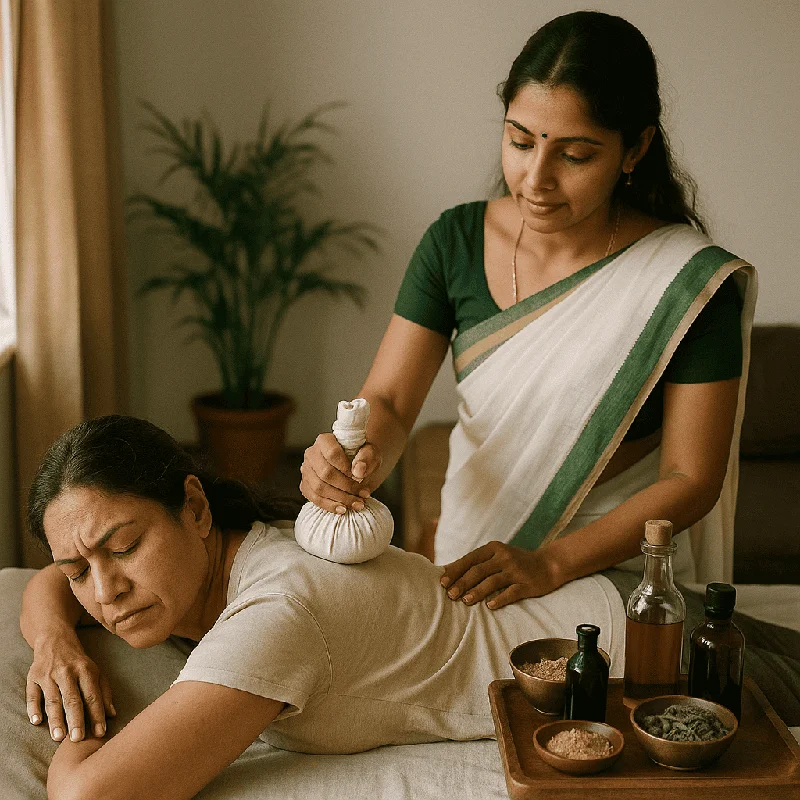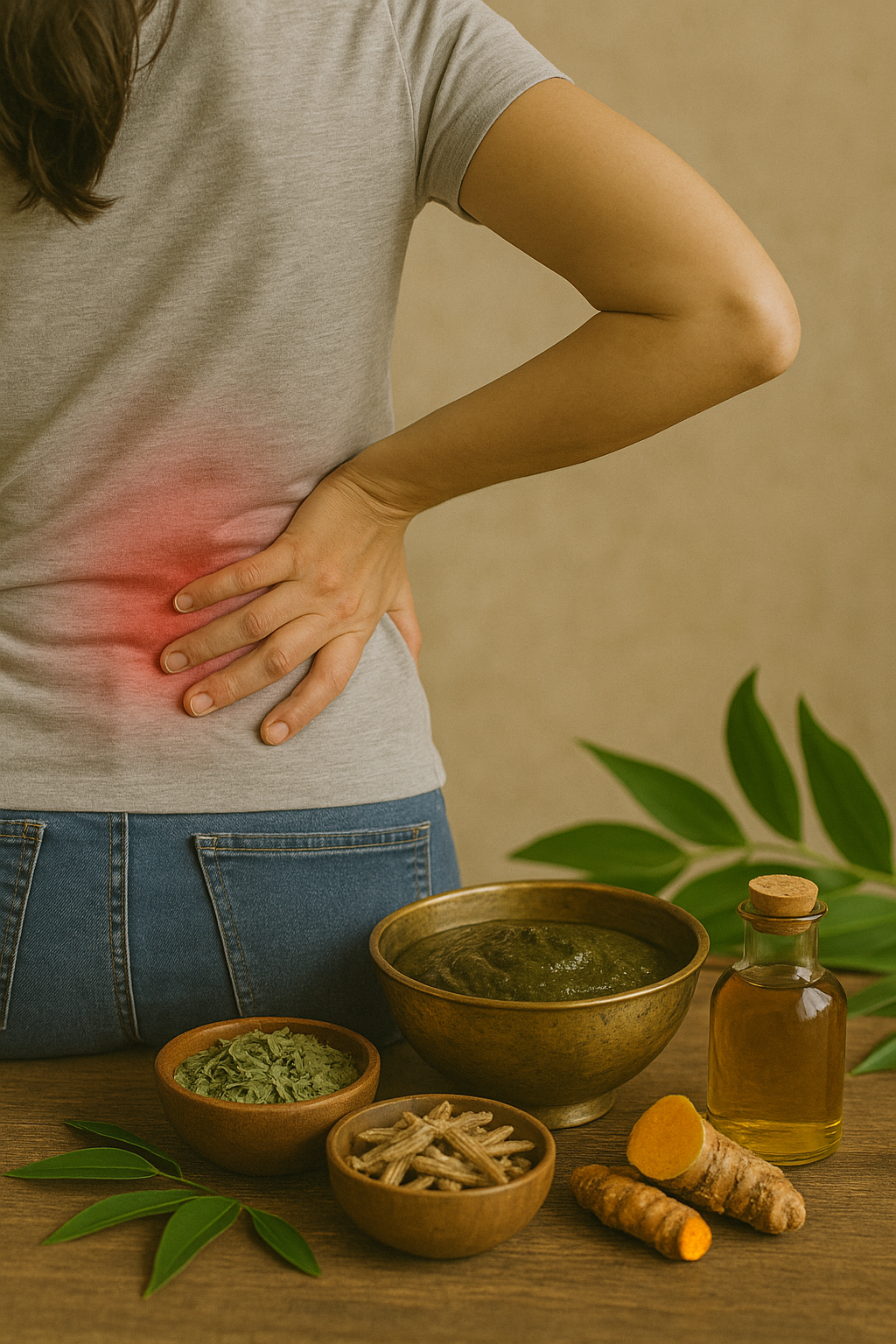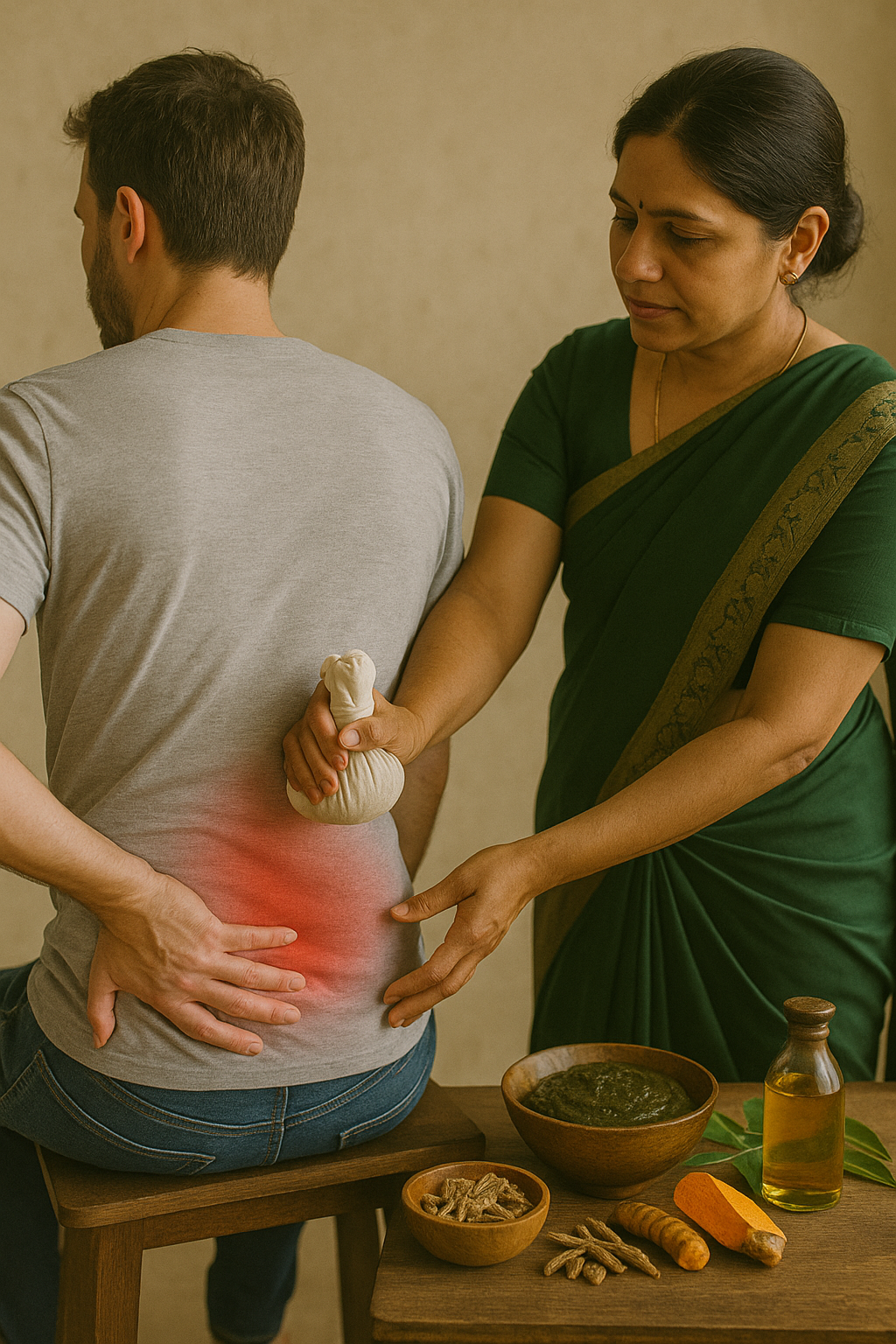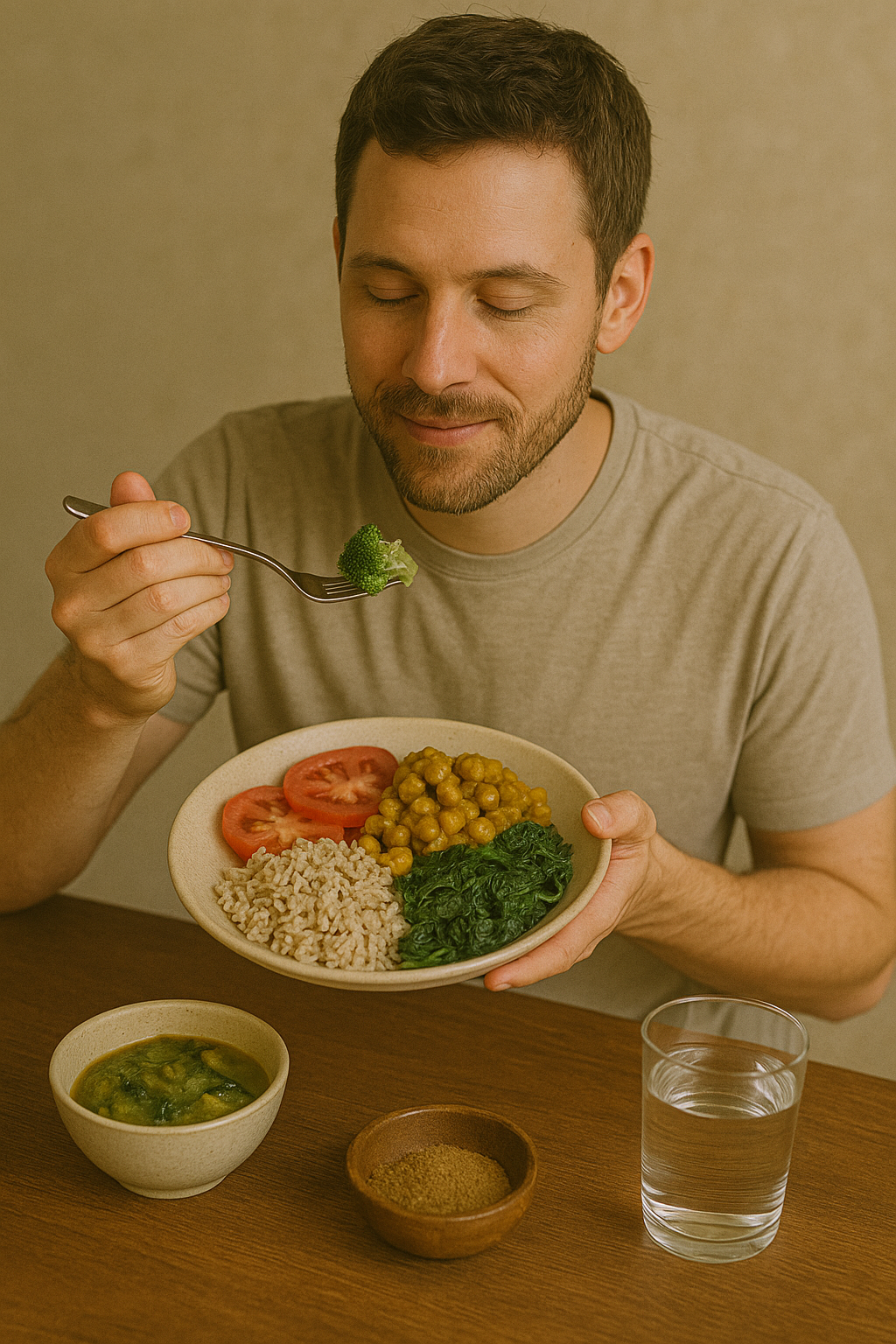Ask Ayurvedic doctor a question and get a consultation online on the problem of your concern in a free or paid mode. More than 2,000 experienced doctors work and wait for your questions on our site and help users to solve their health problems every day.
Shop Now in Our Store
Ayurvedic Treatment for Back Pain: What You Should Know (and What Most People Get Wrong)

Introduction
Back pain. Two little words that feel like they’ve quietly hijacked modern life.
If you’ve ever groaned while getting out of bed, shifted awkwardly in your chair by 3 PM, or found yourself standing oddly at a party because your lower back “just won’t loosen up today,” then welcome to the club. You’re not alone—nearly 80% of adults experience back pain at some point, and it’s fast becoming one of the top reasons people visit a doctor, take time off work, or just feel... older than they are.
Now, toss in Ayurveda—the ancient Indian system of natural healing—and suddenly things get interesting. Ayurvedic treatment for back pain doesn’t just toss painkillers your way or suggest vague stretches. It digs into the root causes—how your doshas are behaving, what foods you’re eating, even what emotional baggage you’re carrying.
Wait—emotions? Yes, seriously. In Ayurveda, pain isn’t just physical. It’s a sign that something in your inner ecosystem is out of whack.
So what are we doing here?
This article is your deep dive into how Ayurveda approaches back pain. We’ll talk about the imbalances that cause it, the early warning signs most people ignore, and the herbs, oils, routines, and therapies that can actually help. We’ll go beyond general advice, into specifics—because vague “self-care” tips aren’t going to cut it when your spine feels like it’s made of rusted metal.
You’ll learn:
-
How Ayurvedic practitioners diagnose the type and source of your pain (and why it matters)
-
What herbs and treatments work for different body types and stages of pain
-
Real stories from people who’ve turned their pain around—without surgery or drugs
-
Which modern habits are quietly destroying your back health
-
And a bunch of practical advice that doesn’t require a guru or a wellness retreat
This is not going to be a typical “top 5 remedies” article. It’s deeper. More nuanced. A little opinionated. Maybe a bit messy in places, but honest and—hopefully—really helpful.
And if nothing else, you’ll never look at your back (or your lifestyle) the same way again.

Understanding Ayurvedic Treatment for Back Pain — An Ayurvedic Overview
Alright, let’s set the stage. Back pain isn’t just "a pain in the back." It’s a whole-body conversation gone sideways.
What exactly is back pain, anyway?
From a conventional medical perspective, back pain is usually categorized based on location (lower, middle, upper), duration (acute vs chronic), and cause (injury, disc problems, arthritis, postural strain, etc). You might get a diagnosis like "lumbar disc herniation" or "degenerative spine disease" and walk out with a prescription or referral for physio.
But the body’s not a machine with spare parts—it’s an integrated system. Pain doesn’t just show up; it evolves. Think of it like this: first, there’s stiffness. Then twinges. Then, maybe a shooting pain or a dull ache that won’t quit. And over time, complications—nerve compression, inflammation, even mobility loss.
From an anatomical view, you’re looking at strained muscles, worn-down joints, pinched nerves, and poor circulation. But Ayurveda? Ayurveda sees it all a bit differently.
The Ayurvedic Angle: It’s All About the Doshas
In Ayurveda, pain is most often linked to Vata dosha—the energy that governs movement, nerve impulses, and space in the body. When Vata is aggravated (too dry, too cold, too mobile), it settles in vulnerable tissues like the spine and causes ruksha (dryness), shula (pain), and stambha (stiffness).
But it’s rarely just Vata. Pitta, with its heat and intensity, can contribute when inflammation or burning sensations are present. And Kapha brings in heaviness, swelling, or dull aches, especially when paired with sedentary habits.
What causes these imbalances?
-
Eating too many dry, processed, or cold foods (yes, that “healthy” salad might be messing with you)
-
Long hours of sitting, poor posture, or irregular routines
-
Emotional suppression—especially fear, anxiety, or grief (yep, emotions again)
-
Old injuries that never truly healed
-
Seasonal changes, especially the cold-dry Vata season (autumn/winter)
In Ayurveda, back pain is seen as a condition of avaranam or obstruction—where Vata's natural movement is blocked by Kapha or Pitta elements. Imagine trying to run water through a twisted hose. That’s your nervous system under doshic pressure.
Ayurveda vs. Modern Medicine: A Different Philosophy of Pain
Here’s where it gets juicy.
Modern medicine often focuses on structural changes—herniated discs, spinal stenosis, etc. You see it on an MRI, you treat it with meds, injections, or surgery. Ayurveda, though? It looks deeper. It says: "Why did this happen in the first place? What systemic imbalance allowed degeneration to take hold?"
Where a doctor might recommend muscle relaxants, an Ayurvedic Vaidya might suggest warm sesame oil massages, ghee-infused herbal decoctions, or specific dinacharya (daily rituals) to restore balance.
It’s not that one is right and the other is wrong. They just ask different questions. Ayurveda sees pain as the smoke—but wants to find the fire.
And if you’ve tried everything else and still have no relief, maybe it’s time to look where no one else has bothered to look: inside your doshas, your digestion, your emotions, and your routine.
Causes and Triggers of Back Pain (Ayurvedic Insights)
Back pain doesn’t just sneak up on you one day like a thief in the night. In Ayurveda, it brews slowly—often for years—before it screams loud enough for you to notice.
Main Underlying Ayurvedic Causes of Back Pain
Okay, this might sound a bit weird at first, but bear with me: not all back pain starts in the back. Ayurvedic texts tell us that imbalances in Agni (digestive fire) and Apana Vata (the downward-moving sub-dosha) often pave the way for chronic pain.
Here's what typically sets things off:
-
Weak digestion → leads to toxin (Ama) buildup → blocks energy channels → pain.
-
Aggravated Vata dosha (especially in older adults) → dries out tissues and joints.
-
Overexertion or strain → both physical and mental → deranges Vata, again.
-
Improper elimination → constipation = blocked flow = discomfort.
-
Suppression of natural urges → this one's so overlooked, but holding in sneezes, urine, even emotions, creates stagnation.
You’d be surprised how often the origin of the problem is in the gut. Really.
Common Triggers and Risk Factors in Ayurveda
Let’s get into some everyday stuff that seems harmless but can absolutely mess up your back from an Ayurvedic lens:
-
Cold weather + cold food + cold drinks = Vata overload.
-
High caffeine intake → dries the system out.
-
Skipping meals, irregular eating times → weakens Agni, throws rhythms off.
-
Sleeping on a soft mattress (yes, even the expensive ones) → poor spinal alignment.
-
Wearing high heels, carrying heavy bags on one side only, etc.
-
Too much screen time → not just because of posture, but also due to overstimulation of the nervous system.
Ayurveda doesn’t isolate the back from the rest of you. That’s the key.
Why Modern Lifestyles Are Fueling More Back Pain Than Ever
Let’s be honest: we’re not living like our ancestors. We sit too much, eat out of plastic, stare at phones until midnight, and then wonder why our body’s rebelling.
Ayurveda calls this Asatmya Indriyartha Samyoga—basically, an unnatural connection between the senses and the world around us.
Add to that:
-
Lack of Dinacharya (daily routine)
-
Overwork and chronic stress (burnout is a big Vata thing)
-
Eating while multitasking or stressed
-
Inconsistent sleep schedules
And boom—your back’s had enough.
Recognizing Symptoms & Early Signs of Back Pain
Back pain isn’t just about pain. Sometimes, it starts with signs we brush off as “normal.” Spoiler: they’re not.
Typical Symptoms (In Detail, Please)
Depending on which dosha is involved, back pain symptoms can vary wildly. Here's what that might look like:
-
Vata-type pain: Sharp, stabbing, shifting discomfort. Worse at night or in cold/dry weather. Might come with bloating, anxiety, insomnia.
-
Pitta-type pain: Burning sensation, inflammation, localized heat. May worsen after spicy foods or anger.
-
Kapha-type pain: Dull, heavy ache, stiffness in the morning, feeling of heaviness. Better after movement.
Other common symptoms include:
-
Reduced flexibility
-
Sciatica-type sensations (pain radiating down the leg)
-
Muscle spasms
-
Numbness or tingling
-
Fatigue that seems disproportionate
The Sneaky Signs Most People Miss
Now for the less obvious stuff:
-
Constipation or sluggish bowels
-
Cracking joints when you stretch
-
Worsening pain with wind or cold exposure
-
Loss of appetite or unpredictable hunger patterns
-
Feeling mentally ungrounded or “wired but tired”
These might not scream back pain, but from an Ayurvedic point of view, they’re early whispers of imbalance—especially Vata.
When to Seek Ayurvedic Help (and When Not To)
You don’t need to wait until you’re doubled over to see an Ayurvedic practitioner. If any of the above signs sound familiar—or if your pain:
-
Repeats in cycles
-
Moves around
-
Doesn’t fully resolve with rest or meds
-
Comes with digestive or emotional disturbances
…it’s time.
BUT—and this is important—Ayurveda isn't magic. If your back pain involves red-flag symptoms like sudden weight loss, loss of bowel/bladder control, or unrelenting night pain, get a medical diagnosis first. Ayurveda works best in collaboration with modern care when things are severe.
Ayurvedic Diagnosis Methods for Back Pain
If you’ve never had a proper Ayurvedic consultation, you're in for something different. It's slower, deeper, more holistic.
Pulse, Tongue & Other Traditional Techniques
Ayurvedic diagnosis is called Rogi-Roga Pariksha, and it’s got layers:
-
Nadi Pariksha (Pulse diagnosis): Using three fingers, the practitioner feels the radial pulse to assess Vata, Pitta, and Kapha. They’re sensing rhythm, strength, qualities. It’s subtle—some say it feels almost poetic.
-
Jihva Pariksha (Tongue examination): The tongue can show Ama (toxins), dosha dominance, digestive health, organ involvement. White coating? That’s undigested gunk.
-
Drik Pariksha (Eye exam), Sparsha (Palpation), Shabda (Voice quality)—even the way you talk or walk gives clues.
No blood tests? Nope. But often, the accuracy stuns patients. Especially when their Vaidya casually asks, “You’re not sleeping well, are you?” before you even sit down.
Identifying the Dosha Imbalance Behind Your Pain
This part is crucial because treatments depend entirely on your dosha profile.
-
If Vata is high: You may be dry, cold, gassy, anxious, constipated.
-
If Pitta is high: You’re probably inflamed, irritable, overheated.
-
If Kapha is high: You’ll feel heavy, dull, slow, lethargic.
And sometimes? It’s a combination.
Dosha imbalance also shifts depending on the season, age, and environment. That’s why a good practitioner won’t just ask what hurts—they’ll ask about your sleep, digestion, mood, relationships, even childhood patterns.

Ayurvedic Treatments & Remedies for Back Pain
Let’s talk solutions. Real, earthy, herbal, oily, grounding solutions. Ayurveda doesn’t shy away from hands-on care.
Herbs and Medicines That Actually Work
Alright, let’s walk through some of the most trusted Ayurvedic remedies for back pain—no fluff, just the good stuff.
-
Ashwagandha: If your back pain comes with stress, exhaustion, or general frailty, Ashwagandha is your friend. It’s usually taken as a powder or capsule and works by strengthening the nervous system and calming an aggravated Vata dosha. It’s also one of those rare herbs that helps both your body and your mind.
-
Guggulu (especially Yograj Guggulu or Kaishor Guggulu): This resin-based remedy is incredible for deep-seated joint and bone pain. Guggulu helps clear toxins, improve circulation, and reduce inflammation. It’s especially helpful when pain feels sticky, swollen, or doesn’t go away easily. Comes in tablet or decoction form, depending on what you’re dealing with.
-
Shallaki (Boswellia): Think of this one as Ayurveda’s answer to ibuprofen—but without the gut-wrecking side effects. Shallaki is best known for reducing swelling and improving mobility in inflamed joints. Ideal for those with more Pitta-related back pain—burning, sharp, or worsened with heat.
-
Dashmool: The name literally means “ten roots,” and that’s exactly what it is—a root-based formula that balances both Vata and Kapha. It’s often used as a decoction (boiled herbal tea) or as an oil in massages. Dashmool is especially effective for pain with stiffness, spasms, or where things just feel “stuck.”
-
Nirgundi: You’ll find this herb in a lot of local pain oils. It's not for internal use, typically, but works wonders as an external application. When used as a paste or warm medicated oil on the painful area, Nirgundi helps reduce swelling and soothe the nerves. It's particularly effective when pain is superficial or muscular.
Just a gentle reminder: these aren’t generic wellness supplements. They’re potent medicines, and the right one depends on your dosha, the stage of your condition, and your overall constitution. Plus, some of them aren't suitable during pregnancy, while breastfeeding, or for people with liver issues or autoimmune conditions.
So always, always check with a qualified Ayurvedic practitioner before trying them.
Therapies & Panchakarma That Help
Some Ayurvedic therapies feel like spa treatments... but they’re therapeutic, not just indulgent.
-
Abhyanga (Warm oil massage) – calms Vata, nourishes tissues
-
Kati Basti – warm medicated oil held over lower back in a dough dam
-
Pizhichil – oil pouring for deep relaxation and pain relief
-
Basti (medicated enema) – the gold standard for chronic Vata pain
-
Swedana (herbal steam) – reduces stiffness and clears Ama
These are usually done in clinics, over multiple sessions, and tailored to your constitution.
Simple Home Remedies & Self-Care You Can Start Today
You don’t need a full Panchakarma retreat to begin healing.
Try these:
-
Apply warm sesame oil daily before showering. It’s grounding and helps prevent dryness.
-
Drink ginger tea with a pinch of turmeric and black pepper—anti-inflammatory and supports digestion.
-
Soak in Epsom salt baths if your back allows—helps relax muscles.
-
Eat warm, cooked, spiced foods—no salads or cold smoothies while healing!
-
Stretch gently, especially spinal twists and hip openers.
Small steps. Big shifts.
Diet & Lifestyle Recommendations for Managing Back Pain
In Ayurveda, you don’t just treat symptoms—you change how you live. That includes what you eat, when you sleep, how you breathe, and even what kind of thoughts you carry around.
Let’s break it down.
Recommended Foods and Dietary Guidelines for Back Pain
First things first: if Vata is high (which it usually is in back pain), you need grounding, warming, moistening foods. Think soups, stews, kitchari, and ghee—foods that bring lubrication and stability back to your tissues.
Specific food tips:
-
Grains: Favor warm, soft options like rice, oats, quinoa. Add ghee. Avoid popcorn or dry crackers—they’ll worsen dryness.
-
Spices: Ginger, turmeric, cumin, fennel, ajwain. These ignite Agni (digestive fire) and reduce Ama (toxins).
-
Legumes: Mung dal is great. Others can be hard to digest unless spiced well.
-
Fruits: Ripe bananas, cooked apples with cinnamon, stewed pears. Avoid raw, cold, or sour fruits.
-
Vegetables: Cooked is key. Favor root veggies like sweet potatoes, carrots, and beets. Skip raw salads during flare-ups.
-
Dairy: Warm milk with a pinch of turmeric or nutmeg can help sleep and healing. Cold milk? Avoid.
-
Oils: Sesame oil and ghee are your best friends. They lubricate and nourish the joints.
-
Meal timing: Eat at regular times. Don’t skip meals. Don’t multitask while eating.
Also: chew your food. It's not a race.
Foods and Drinks to Avoid
There’s a long list here, but let’s keep it real and doable. If you want your back to heal, cut these out or at least minimize:
-
Cold drinks and ice water: Huge Vata aggravators. They put out your digestive fire.
-
Raw food: Especially in cold weather or if you’re already feeling “off.”
-
Caffeine and alcohol: Dehydrate the tissues, disturb sleep, and unground the nervous system.
-
Refined sugar: Increases inflammation. Also messes with mood and energy levels.
-
Dry or packaged snacks: Chips, crackers, cereals. They pull moisture from the system.
-
Too much nightshade vegetables (like tomatoes, eggplants, potatoes): May worsen joint pain in sensitive individuals.
-
Fermented or sour foods (like vinegar, yogurt, pickles): Can increase Pitta and lead to inflammation.
And for the love of your spine: no eating late at night.
Daily Routine and Lifestyle Tips to Control Back Pain
Your body wants rhythm. Ayurveda calls this Dinacharya—a daily routine that stabilizes your doshas and supports long-term healing.
Here’s what an ideal Vata-pacifying routine might look like:
-
Wake up before sunrise, if possible. It helps align your body clock.
-
Oil massage (Abhyanga) with warm sesame oil before your shower. Even 10 minutes can change everything.
-
Warm shower or bath—not too hot, but definitely not cold.
-
Eat breakfast before 9 AM, lunch as your main meal around noon, and dinner by 7 PM. Light at night.
-
No screen time 30 minutes before bed. Read. Breathe. Listen to soft music. Let your nervous system unwind.
-
Stretch gently daily, especially hips and hamstrings. No intense workouts during flare-ups.
-
Practice grounding yoga: slow sun salutations, cat-cow, legs-up-the-wall, child’s pose. Avoid heavy backbends or fast vinyasa.
-
Sleep by 10 PM. Your spine and nerves regenerate while you rest.
Consistency matters more than perfection.
Ayurvedic Herbs and Medicines for Ongoing Support
We touched on some in Part 7, but here’s a deeper look into how and when to use them:
-
Ashwagandha: Take 3–5g powder with warm milk at night to soothe nerves and promote recovery. Capsules work too.
-
Guggulu-based formulas: Usually taken twice a day after meals. Be cautious if you have sensitive digestion.
-
Dashmool decoction: Can be used as a daily tonic for deep-seated pain and inflammation. Ask a practitioner to customize the dose.
-
Mahanarayan oil: For external application—great before bath or bedtime.
-
Shallaki (Boswellia): Especially effective when inflammation is involved. Capsules 1–2 times daily after meals.
Warnings: Always consult a professional if you’re pregnant, breastfeeding, or have chronic conditions like IBS, hypertension, or autoimmune disease. Ayurveda is powerful—but not one-size-fits-all.

Real Patient Experiences & Success Stories
Let me tell you about “Rita,” a 42-year-old teacher I met in Kerala. She had been dealing with lower back pain for 7 years. MRI showed “mild disc bulge”—nothing surgical, but enough to affect her sleep, mood, and work.
She started daily Abhyanga with sesame oil, switched to warm, spiced foods, and received 14 days of Panchakarma (Kati Basti, gentle Basti therapy, Dashmool decoction). She also took Ashwagandha and Yograj Guggulu under supervision.
By week two, she could sit comfortably through her lessons again. Three months later, she messaged her doctor: “I forgot I even had a back problem.”
There’s also Rajiv, a startup founder. Chronic back pain from long hours at the desk. For him, it wasn’t physical alone—it was anxiety and burnout. Ayurveda focused on Vata balancing through Shirodhara, lifestyle shifts, and emotional release. In his words: “I didn’t just fix my back. I got my life back.”
Every case is different, but relief is possible.
Scientific Evidence & Research on Ayurvedic Effectiveness for Back Pain
Now, you might be wondering—is this stuff actually studied? Yes. And more than you’d think.
Quick Research Highlights
-
A 2020 study published in the Journal of Ayurveda and Integrative Medicine found that Kati Basti (localized oil pooling) significantly reduced lower back pain in participants over four weeks—better than physiotherapy alone.
-
Another clinical trial showed that Yograj Guggulu + Dashmool decoction led to notable improvements in chronic lumbago, especially when combined with diet and lifestyle adjustments.
-
Ayurvedic massage therapies were found to improve pain intensity and mobility in mechanical back pain, according to a review published in Evidence-Based Complementary and Alternative Medicine.
Ayurveda vs. Conventional Medicine: A Quick Comparison
Conventional care often focuses on:
-
Pain relief (NSAIDs, muscle relaxants)
-
Imaging (MRI, X-ray)
-
Physical therapy or surgery when things get severe
Ayurveda focuses on:
-
Identifying root cause via dosha imbalance
-
Personalized diet, herbs, and routines
-
Long-term prevention and regeneration
That’s not to say modern care is bad—it’s incredibly useful. But Ayurveda offers a deeper reset, especially when pain lingers beyond diagnostics.
Trusted Sources for Further Reading
Here are some go-to sources that support Ayurvedic research and treatments:
-
The National Center for Complementary and Integrative Health (NCCIH) -
AYUSH Ministry, Government of India -
PubMed -
All India Institute of Ayurveda -
Dr. Vasant Lad’s Ayurvedic Institute
Common Misconceptions About Back Pain and Ayurveda
Let’s bust a few myths:
-
“Ayurveda is too slow to work.” Not true. When done properly, some people feel relief within days. Long-term healing takes time, sure—but so does chronic pain.
-
“You need to give up everything fun to follow Ayurveda.” Nah. It’s about balance, not punishment.
-
“If it’s herbal, it’s safe.” Dangerous mindset. Many herbs are strong medicine and need supervision.
-
“Back pain is just a part of aging.” Absolutely not. Aging doesn’t mean pain—it means adjustment.
Conclusion
Back pain is not just a condition—it’s a message. A nudge to slow down, rebalance, and reconnect with your body.
Ayurveda doesn’t offer a quick fix. It offers a full-spectrum approach—nourishing, cleansing, rebuilding, and personalizing the path back to wellness.
Whether your pain is new, chronic, or somewhere in between, Ayurvedic treatment for back pain can help. But only if you’re ready to look deeper, commit to change, and trust in a system that’s been helping people for over 5,000 years.
So—next time your back protests, don’t just silence it. Listen.
And if you’re unsure where to start? Visit Ask-Ayurveda.com and get a personalized consultation. One step can change everything.
Frequently Asked Questions (FAQ)
1. Can Ayurveda cure chronic back pain completely?
Ayurveda doesn’t promise “cures” in the modern medical sense—but it can bring lasting relief, better function, and deep systemic balance. Many people report total resolution with consistent treatment.
2. How long does it take to see results with Ayurvedic treatment?
Some feel better within days; others take weeks or months depending on how chronic or complicated the pain is. Panchakarma often accelerates recovery.
3. Is Panchakarma necessary for all back pain cases?
Not always. For mild to moderate pain, herbs, diet, and external therapies might be enough. Panchakarma is recommended when deeper detox or rejuvenation is needed.
4. Can I follow Ayurveda while also seeing a modern doctor?
Absolutely. In fact, the best results often come from combining systems. Just be sure both practitioners know what you’re taking.
5. Are Ayurvedic herbs safe during pregnancy?
Many are not. Always consult a qualified Vaidya before using any herbs if you’re pregnant, breastfeeding, or have chronic health issues.
References & Authoritative Sources
For more information and research-backed insights on Ayurveda and back pain, visit these reputable sites:
-
– National Center for Complementary and Integrative Health
-
– Ministry of AYUSH, Govt. of India
-
– PubMed
-
– All India Institute of Ayurveda
-
– Ayurvedic Institute by Dr. Vasant Lad
This article is checked by the current qualified Dr Sujal Patil and can be considered a reliable source of information for users of the site.

